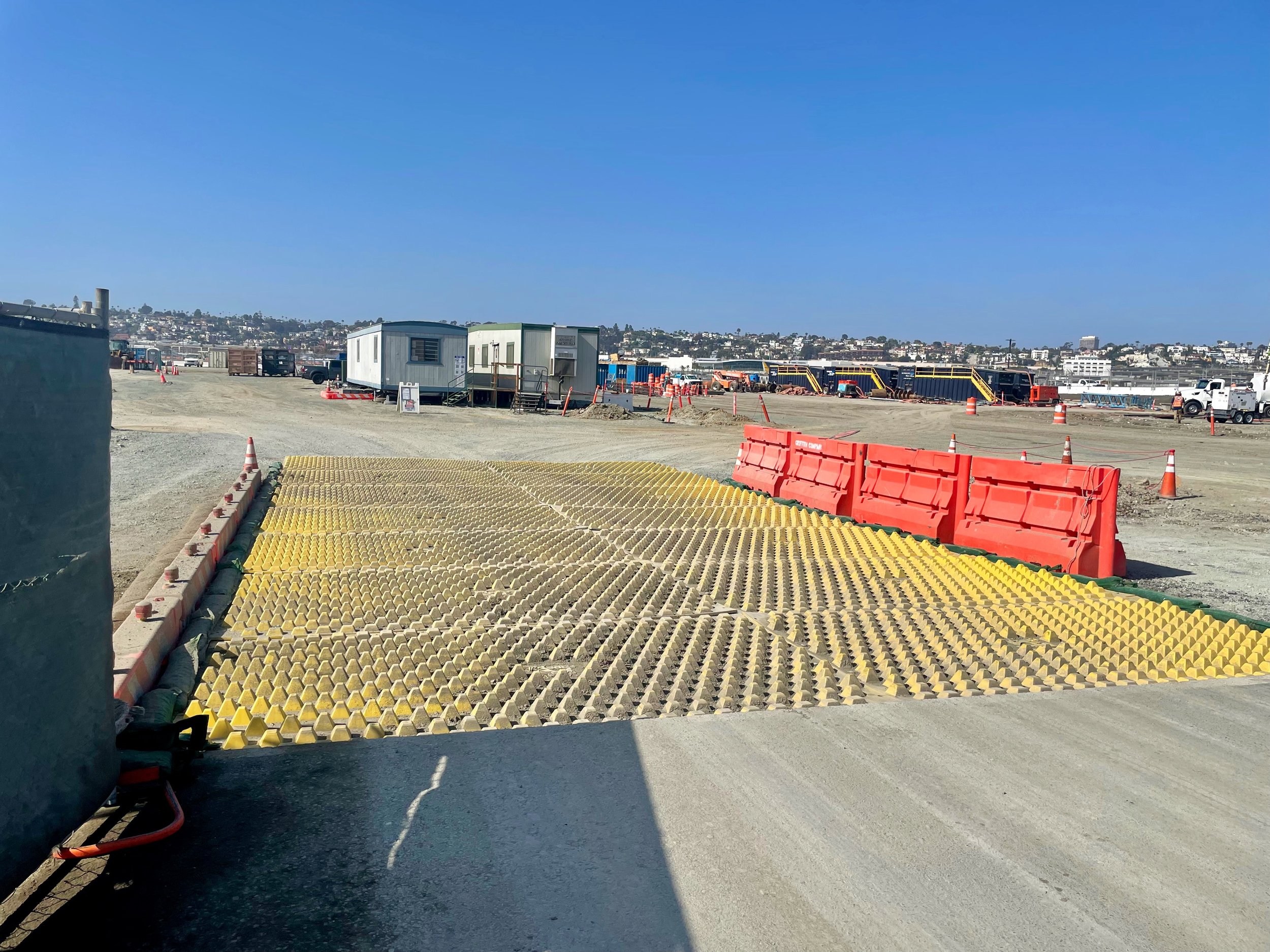SAN Airport - New T1 Project
Over 200 FODS Mats in Use on $3.4 Billion New T1 Project
In 1928, the San Diego airfield became the first federally certified airfield that could host all plane types. The airport has since added two terminals and other enhancements as traffic has increased. Today, the San Diego International Airport (SAN) is America's busiest single-runway commercial airport.
Terminal 1
Terminal 1 at San Diego International Airport
Originally built in 1967, Terminal 1 served 2.5 million passengers over the first year of operation. Recently, this number has grown to over 11 million annual passengers which prompted the San Diego Regional Airport Authority to begin planning the terminal's expansion. The planning stage has included over 100 community meetings as well as an environmental study. After a federal environmental impact analysis was completed in October, 2021, the Airport Authority broke ground on what would be the largest undertaking in the airport's history. At $3.4 billion, The New T1 Project is over 3 times larger than the previous $1 billion The Green Build Terminal 2 Expansion completed in 2013. The 1.2 million-square-foot building will prepare the airport for future growth which is expected to reach 39 million annual visitors by 2035.
San Diego New T1 Project
Render of New T1 Terminal Approach.
The New T1 Project includes multiple enhancements to the existing Terminal. Upon completion, the terminal will have a total of 30 gates after the 11 new gates are constructed with associated seating areas, security checkpoints, and restaurants. A new three-lane entry roadway will be constructed to increase access to the terminal while easing congestion from other entry roadways, a two-level roadway and curb front will separate array and departure traffic to further streamline traffic. Surface parking lots will be replaced with a close-in parking plaza providing up to 5,500 parking spaces. An additional public transportation area will be established for a future transit station to receive passengers from a regional transit connection. In addition to the increasing capacity, the New T1 Project will include features designed to make traveling more enjoyable. The Terminal will include up to two lounge areas, a designated children's play area, multiple art pieces, and an outdoor patio which will offer views of the San Diego Bay.
The New T1 Project has been divided into three sections: A New Administration Building which is being built by Sundt in collaboration with HOK as lead architect along with civil engineering and LEED consulting from C&S Companies, an Airside Improvements Project delivered by Griffith Company to improve aircraft taxiing routes, and the Terminals & Roadways component which will be completed by a Joint Venture led by Flatiron with Gensler as lead architect. The first section scheduled for completion is the administration building which is expected to open in 2023. The entire project will continue until late 2027 and create between 15,000 and 20,000 construction related jobs.
Construction Track-Out Controls & FOD Prevention
FODS Installed On New T1 Terminal Project in a two lane configuration.
Additional Construction Track-Out Control installed on New T1 Project in conjunction with aggregate roadway.
Operators of construction operations like the New T1 Project which disturb an area of one acre or greater are required to implement control measures (also called Best Management Practices or BMPs) to meet permit conditions of the National Pollution Discharge Elimination System (NPDES) established by the EPA's Clean Water Act. One of the first structures to be installed is the Construction Track-Out Controls (TC-1) which contain sediment and debris within the job site to prevent contamination of storm drains and nearby surface waters. Similar control measures are commonly installed as a permanent feature on airfields to prevent Foreign Object Debris (FOD) from entering runways and taxiways. Airport operators work to keep runways clear of debris from multiple sources including wildlife and debris from airport activity which can damage aircraft. During airport construction operations, Track-Out control measures serve a dual purpose of fulfilling the NPDES permit requirements as well as helping to reducing debris that enters access roads which can be tracked onto taxiway intersections.
Because reducing track-out and controlling FOD is a high priority on construction projects, C&S Companies chose to specify the FODS Trackout Control System Mat as the Construction Track-Out Control (TC-1) BMP on the Airside Improvements Project. Compared to traditional Track-Out Controls, the FODS system is highly effective at both sediment removal and capture. Because the FODS system does not introduce additional rock onto the site, the risk of crushed rocks becoming tracked onto roadways and taxiways is significantly reduced aiding efforts to keep the operating airfield safe during construction operations. The FODS Trackout Control System is also being used on the Terminals & Roadways project. The contractor is able to relocate the portable FODS system as construction entrance locations move throughout each of the project phases. Over 200 FODS Trackout Control Mats are strategically integrated into the project to reduce sediment tracking and protect the airfield access roads from fugitive debris. With a 10+ year expected service life, the mats can continue to be reused through the project's expected completion in 2027.
FODS Airport Construction & Permanent Applications
Around the world, airports construction projects and aircraft manufacturing plants have implemented the FODS System as both a Construction Track-Out Control and as a permanent FOD Control Measure. This modern system enables airport and construction operators to increase safety and stay compliant with SWPPP and FOD Control Plans. When installed as a permanent feature on access roads, the system is a passive control for foreign object debris that is tracked in from external roadways. On construction applications, FODS serve as an effective construction entrance which can be maintained on-site enabling greater compliance throughout the project.
Learn more about FODS in use on Airport Construction Projects in Permanent FOD Control Applications.
ABOUT FODS, LLC.
Based in Englewood Colorado, FODS Trackout Control System replace ineffective and costly traditional rock stabilized construction entrances, saving you time and money. Our proprietary mat design works to effectively remove debris from your vehicle tires without damaging the tire or the ground’s surface. We provide the only durable, reusable, and environmentally friendly trackout control system currently available on the market. FODS Reusable Construction Entrances are 100% Made In the USA and 100% recyclable.
To find out more information on how we can help your project stay on schedule and in compliance contact 844-200-3637 or email us at info@getfods.com.




